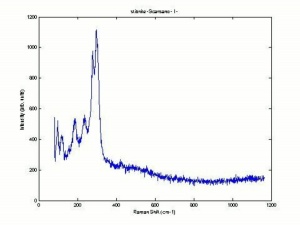Difference between pages "Kunisada, Actor Sawamura Tanosuke II, from the series Actor Rebuses, 11.42324" and "Antimony black"
(Difference between pages)
Jump to navigation
Jump to search
| Line 1: | Line 1: | ||
| − | [[File: | + | [[File:Stibniteemr2.jpg|thumb|Stibnite]] |
| + | == Description == | ||
| − | + | An unstandardized name that has been used both for the black allotropic form of [[antimony|antimony]] and for ground stibnite, which is a soft black [[antimony%20trisulfide|antimony trisulfide]]. The black powder was occasionally used as an eye paint in Egypt from the Amarna period onwards (Ogden 2000). Antimony black powder was used since the late 17th century to blacken the edges of books (Roberts and Etherington 1982). | |
| + | [[[SliderGallery rightalign|stibniteitaly2.jpg~Raman]]] | ||
| + | == Synonyms and Related Terms == | ||
| − | + | stibnite (mineral); CI 77050; negro de antimonio (Esp.); noir d'antimoine (Fr.); nero d'antimonio (It.); negro de antimónio (Port.) | |
| − | + | == Risks == | |
| − | + | * Toxic | |
| + | * Loba Chemie: [https://www.lobachemie.com/lab-chemical-msds/MSDS-ANTIMONY-III-SULPHIDE-BLACK-CASNO-1345-04-01458-EN.aspx SDS] | ||
| − | + | ==Resources and Citations== | |
| + | * J. Ogden, "Metals" in ''Ancient Egyptian Materials and Technology'', P.Nicholson, I.Shaw (eds.), Cambridge University Press, 2000, p. 149. | ||
| − | '' | + | * Ralph Mayer, ''A Dictionary of Art Terms and Techniques'', Harper and Row Publishers, New York, 1969 (also 1945 printing) |
| − | + | * Matt Roberts, Don Etherington, ''Bookbinding and the Conservation of Books: a Dictionary of Descriptive Terminology'', U.S. Government Printing Office, Washington DC, 1982 | |
| − | + | * Monona Rossol, ''The Artist's Complete Health and Safety Guide'', Allworth Press, New York, 1994 | |
| − | |||
| − | |||
| − | |||
| − | |||
| − | |||
| − | |||
| − | |||
| − | |||
| − | |||
| − | |||
| − | |||
| − | |||
| − | |||
| − | |||
| − | |||
| − | |||
| − | |||
| − | + | ||
| − | + | [[Category:Materials database]] | |
| − | |||
| − | |||
| − | [[Category: | ||
| − | |||
| − | |||
| − | |||
| − | |||
Latest revision as of 14:19, 27 April 2022
Description
An unstandardized name that has been used both for the black allotropic form of Antimony and for ground stibnite, which is a soft black Antimony trisulfide. The black powder was occasionally used as an eye paint in Egypt from the Amarna period onwards (Ogden 2000). Antimony black powder was used since the late 17th century to blacken the edges of books (Roberts and Etherington 1982).
Synonyms and Related Terms
stibnite (mineral); CI 77050; negro de antimonio (Esp.); noir d'antimoine (Fr.); nero d'antimonio (It.); negro de antimónio (Port.)
Risks
- Toxic
- Loba Chemie: SDS
Resources and Citations
- J. Ogden, "Metals" in Ancient Egyptian Materials and Technology, P.Nicholson, I.Shaw (eds.), Cambridge University Press, 2000, p. 149.
- Ralph Mayer, A Dictionary of Art Terms and Techniques, Harper and Row Publishers, New York, 1969 (also 1945 printing)
- Matt Roberts, Don Etherington, Bookbinding and the Conservation of Books: a Dictionary of Descriptive Terminology, U.S. Government Printing Office, Washington DC, 1982
- Monona Rossol, The Artist's Complete Health and Safety Guide, Allworth Press, New York, 1994

